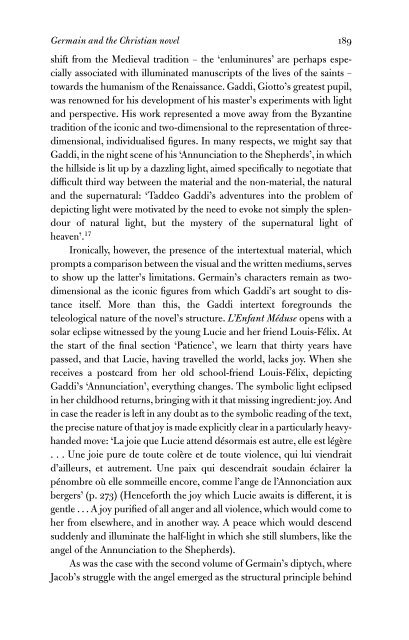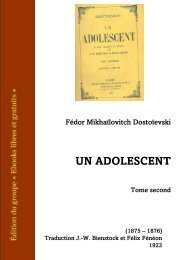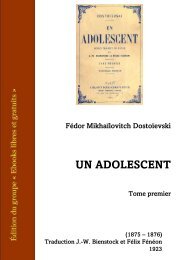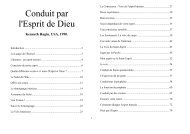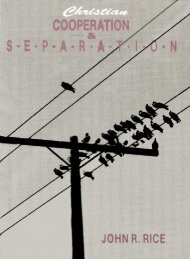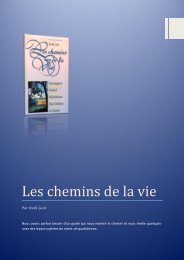Women writing in contemporary France
Create successful ePaper yourself
Turn your PDF publications into a flip-book with our unique Google optimized e-Paper software.
Germa<strong>in</strong> and the Christian novel 189<br />
shift from the Medieval tradition – the ‘enlum<strong>in</strong>ures’ are perhaps especially<br />
associated with illum<strong>in</strong>ated manuscripts of the lives of the sa<strong>in</strong>ts –<br />
towards the humanism of the Renaissance. Gaddi, Giotto’s greatest pupil,<br />
was renowned for his development of his master’s experiments with light<br />
and perspective. His work represented a move away from the Byzant<strong>in</strong>e<br />
tradition of the iconic and two-dimensional to the representation of threedimensional,<br />
<strong>in</strong>dividualised figures. In many respects, we might say that<br />
Gaddi, <strong>in</strong> the night scene of his ‘Annunciation to the Shepherds’, <strong>in</strong> which<br />
the hillside is lit up by a dazzl<strong>in</strong>g light, aimed specifically to negotiate that<br />
difficult third way between the material and the non-material, the natural<br />
and the supernatural: ‘Taddeo Gaddi’s adventures <strong>in</strong>to the problem of<br />
depict<strong>in</strong>g light were motivated by the need to evoke not simply the splendour<br />
of natural light, but the mystery of the supernatural light of<br />
heaven’. 17<br />
Ironically, however, the presence of the <strong>in</strong>tertextual material, which<br />
prompts a comparison between the visual and the written mediums, serves<br />
to show up the latter’s limitations. Germa<strong>in</strong>’s characters rema<strong>in</strong> as twodimensional<br />
as the iconic figures from which Gaddi’s art sought to distance<br />
itself. More than this, the Gaddi <strong>in</strong>tertext foregrounds the<br />
teleological nature of the novel’s structure. L’Enfant Méduse opens with a<br />
solar eclipse witnessed by the young Lucie and her friend Louis-Félix. At<br />
the start of the f<strong>in</strong>al section ‘Patience’, we learn that thirty years have<br />
passed, and that Lucie, hav<strong>in</strong>g travelled the world, lacks joy. When she<br />
receives a postcard from her old school-friend Louis-Félix, depict<strong>in</strong>g<br />
Gaddi’s ‘Annunciation’, everyth<strong>in</strong>g changes. The symbolic light eclipsed<br />
<strong>in</strong> her childhood returns, br<strong>in</strong>g<strong>in</strong>g with it that miss<strong>in</strong>g <strong>in</strong>gredient: joy. And<br />
<strong>in</strong> case the reader is left <strong>in</strong> any doubt as to the symbolic read<strong>in</strong>g of the text,<br />
the precise nature of that joy is made explicitly clear <strong>in</strong> a particularly heavyhanded<br />
move: ‘La joie que Lucie attend désormais est autre, elle est légère<br />
. . . Une joie pure de toute colère et de toute violence, qui lui viendrait<br />
d’ailleurs, et autrement. Une paix qui descendrait souda<strong>in</strong> éclairer la<br />
pénombre où elle sommeille encore, comme l’ange de l’Annonciation aux<br />
bergers’ (p. 273) (Henceforth the joy which Lucie awaits is different, it is<br />
gentle ...Ajoypurified of all anger and all violence, which would come to<br />
her from elsewhere, and <strong>in</strong> another way. A peace which would descend<br />
suddenly and illum<strong>in</strong>ate the half-light <strong>in</strong> which she still slumbers, like the<br />
angel of the Annunciation to the Shepherds).<br />
As was the case with the second volume of Germa<strong>in</strong>’s diptych, where<br />
Jacob’s struggle with the angel emerged as the structural pr<strong>in</strong>ciple beh<strong>in</strong>d


